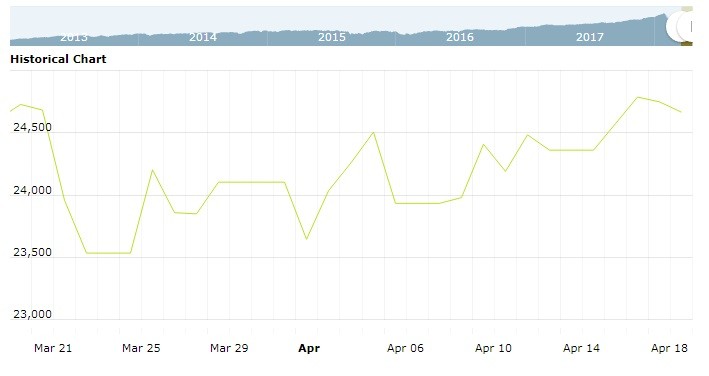U.S. stock futures lower in pre-market trading for Monday, April 23.The Nasdaq Futures is trading at 6,669.25 with a loss of -0.10% percent or -7.00 point.The S&P 500 Futures is trading at 2,669.00 with a loss of -0.09% percent or -2.50 point.The Dow Futures is trading at 24,395.00 with a loss of -0.16% percent or -38.00 point.
In overnight trading in the Eastern Hemisphere,Japan’s Nikkei 225 is trading at 22,088.04 with a loss of -0.33% percent or -74.20 point. Hong Kong’s Hang Seng is trading at 30,315.84 with a loss of -0.34% percent or -102.49 point. China’s Shanghai Composite is trading at 3,065.72 with a loss of -0.19% percent or -5.82 point. India’s BSE Sensex is trading at 34,564.52 up with +0.43% percent or +148.94 point at 12:15 PM.The FTSE 100 is trading at 7,374.62 up with +0.083% percent or +5.38 point. Germany’s DAX is trading at 12,478.47 with a loss of -0.49% percent or ?62.03 point. France’s CAC 40 is trading at 5,396.34 with a loss of -0.30% percent or -16.42 point. The Stoxx Europe 600 is trading at 380.79 with a loss of -0.28% percent or -1.08 point.
Monday’s Factors and Events
Friday’s Activity
U.S. market were lower on Friday.For the day the Dow is trading at 24,462.94 with a loss of -0.82% percent or -201.95 point. The S&P 500 is trading at 2,670.14 with a loss of -0.85% percent or -22.99 point. The Nasdaq Composite is trading at 7,146.13 with a loss of -1.27% percent or -91.93 point
Other leading market index closes included the small-cap Russell 2000 Index closed at 1,564.12 with a loss of -0.62% percent or -9.69 point; the S&P 600 Small-Cap Index closed at 961.76 with a loss of -0.63% percent or -6.05 point; the S&P 400 Mid-Cap Index closed at 1,900.50 with a loss of -0.69% percent or -13.12 point; the S&P 100 Index closed at 1,170.45 with a loss of -0.97% percent or -11.44 point; the Russell 3000 Index closed at 1,584.38 with a loss of -0.81% percent or ?12.88 point; the Russell 1000 Index closed at 1,481.18 with a loss of -0.82% percent or ?12.28 point;


China’s booming economy, demand-led coal-fired plants, and increasing numbers of gasoline vehicles on road have resulted in enormous hazardous emissions over the years, leading to deteriorating air quality in the country. Emissions by vehicles has been among the notable contributors of rising air pollutants.
In this light, and with the rising awareness for health and environmental issues, strong government support, initiatives and investments by OEMs (original equipment manufacturer), China began its journey towards adoption of electric vehicles. Today, mainland China is one of the world’s biggest market for electric vehicles (EV).
In 2013, China’s State Council laid out a roadmap for Air Pollution Prevention and Control (the Action Plan) for the period of 2013-2017 aimed at reducing levels of particulate matter (or PM2.5) by capping coal consumption and encouraging renewable energy.
“From 2013 to 2017, average PM2.5 levels fell 35% in the 74 cities across China for which data is available. Nationwide, about 160,000 premature deaths were avoided in 2017 due to the reduction in pollution” as reported by Greenpeace.
However, much needs to be done. Cities like Beijing are still suffering high levels of hazardous fine PM2.5. Beijing’s general development plan for 2016 to 2035 aims at improving the city’s air quality